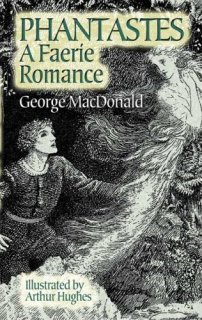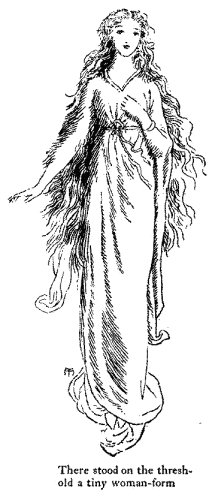 My friend Carrie let me borrow her copy of this wonderful book. It is unlike anything I’ve been reading recently, and I enjoyed the change very much.
My friend Carrie let me borrow her copy of this wonderful book. It is unlike anything I’ve been reading recently, and I enjoyed the change very much.
The book, published in 1905, tells the story of a rich young man who finds his way into Fairy Land. The young man’s name is “Anodos,” which means “pathless” or “ascent” in Greek. He journeys throughout the forest, encountering beauty and evil, ignorance and wisdom, fleeing from the goblin of the Ash Tree and protected by the maiden of the Birch Tree. The language is romantic and carefully constructed. Its intricacy is not merely ornamental, though–each sentence is packed with meaning. I haven’t read “Pilgrim’s Progress,” but it seems to me there may be similiarities; as this character journeys throughout Fairy Land, he encounters temptations that he must resist, and the physical events and decisions he makes frequently have spiritual consequences.
This book takes effort to read, but an effort well worth it. This isn’t the kind of book I would read in one sitting. I’ve taken my time with it, reading a little on the El on my way home from work, some in bed at night, and some with my afternoon coffee.  Each chapter is a beautifully crafted vignette that can be read by itself, and deserves to be slowly chewed on. There is a moral concept to each section, but not one that leaps out at you in an obvious way such as “don’t steal!” The concepts are richer, and are woven into the narration in a much more subtle way. One chapter before going to sleep for me proved extremely delightful–it’s like a bedtime story for adults. In the word of C.S. Lewis, “It will baptize your imagination.”
Each chapter is a beautifully crafted vignette that can be read by itself, and deserves to be slowly chewed on. There is a moral concept to each section, but not one that leaps out at you in an obvious way such as “don’t steal!” The concepts are richer, and are woven into the narration in a much more subtle way. One chapter before going to sleep for me proved extremely delightful–it’s like a bedtime story for adults. In the word of C.S. Lewis, “It will baptize your imagination.”
Right after being betrayed by his own senses into pursuing a maiden whose beauty turns out to be an illusion and whose true face is one of decay, Anodos ponders:
“I took my way I knew not whither, but still towards the sunrise. The birds were singing; but not for me. All the creatures spoke a language of their own, with which I had nothing to do, and to which I cared not to find the key anymore. I walked listelessly along. What distressed me most–more even than my own folly–was the perplexing question, How can beauty and ugliness dwell so near?”
The edition I read was illustrated by Arthur Hughes, in the Pre-Raphaelite style. I love the ink drawings of knights errant and fairies. It added a lovely magic to the pages.
This book isn’t for everyone. It’s not a quick and easy read, but it has a beauty that will slowly seep into your heart with each chapter.
I leave you with some gems of wisdom from the last few pages:
“I knew now, that it is by loving, and not by being loved, that one can come nearest the soul of another; yea, that, where two love, it is the loving of each other, that originates and perfects and assures their blessedness . . . Yet all love will, one day, meet with its return . . . I know that good is coming to me–that good is always coming; though few have at all times the simplicity and the courage to believe it.”
